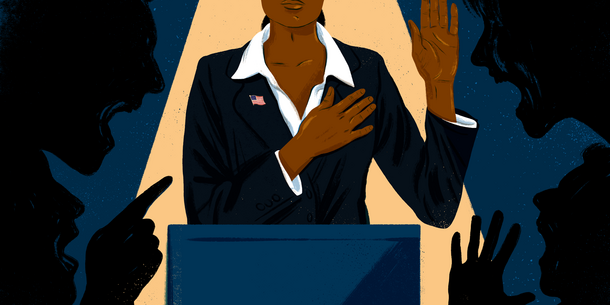A new Brennan Center survey of local election officials reveals that the vast majority have taken steps since 2020 to protect voters, election workers, and election infrastructure from threats and violence in 2024. The enhanced security measures come as large numbers of election officials report having experienced threats, abuse, or harassment for doing their jobs. They also shared ongoing concerns about both the safety of their staff and colleagues, as well as the possibility of political interference in the upcoming election.
The often complex, technical work of administering elections used to occur largely behind the scenes. However, since 2020, election officials have been thrust into the spotlight amid a campaign to undermine faith in American democracy, scapegoated for election outcomes that some politicians and voters do not like. As they perform crucial work under these challenging conditions, election officials report that they need more resources to keep up with administrative and security needs.
Threats, harassment, and abuse
The latest edition of the Brennan Center’s annual survey found that 38 percent of local election officials experienced threats, harassment, or abuse for doing their jobs. Last month, the Department of Justice’s Election Threats Task Force announced it is investigating dozens of threats against election workers and has already convicted 13 individuals. In recent testimony before the U.S. Senate, Isaac Cramer, executive director of South Carolina’s Charleston County Board of Voter Registration and Elections, described how a group traveled to county polling locations to harass election workers during the June 2022 primaries. One of them posted a threatening message online saying, “For all of you on the team tomorrow observing the polls, Good Hunting.” In the aftermath, many Charleston County staff members reported feeling unsafe.
Unfortunately, such fears are not uncommon. Overall, the surveyed election officials’ concerns about physical safety and harassment remain high. More than half of local election officials reported being concerned about the safety of their colleagues or staff — a significantly higher number than in 2023, but about equal to 2022. Similarly, more than one in four worries about being assaulted at home or work. And concern about harassment of family or loved ones reached levels seen in 2022, the last federal election year.
The abuse suffered by officials is fueling an exodus from the field. More than one-third of local election officials know at least one person who resigned at least in part due to safety concerns, up from 22 percent in 2023. We estimate approximately one in four will be administering their first presidential election this year.
2024 election security measures
Since 2020, local election officials have taken action to ensure that elections are safe and secure for everyone. More than 90 percent of local election officials reported having taken steps to increase election security over the past four years, such as participating in security trainings and updating polling place contingency plans and election technology.
For example, in December 2023, the Arizona secretary of state’s office conducted tabletop training exercises for election officials across the state, in which participants rehearsed potential scenarios involving disruptions to elections related to artificial intelligence. The Committee for Safe and Secure Elections has conducted similar exercises in dozens of states, most recently in Michigan. A Colorado law enacted in 2022 requires election offices to keep all voting machines in a location with 24/7 video surveillance and protected by a key card access system that logs the time and person linked to each entrance. Officials in Durham County, North Carolina, and Dane County, Wisconsin, will relocate their election offices to more secure spaces over the next year. While the specifics vary by state and locality, the increased emphasis on security is nearly universal.
Officials have also acted to address staff safety. Arizona election workers have run active-shooter drills and obtained materials to barricade doors. Michigan officials have completed de-escalation trainings, and bullet-resistant glass was installed at the election office in Tallahassee, Florida. Additionally, officials have taken steps to increase safety at the polls. For example, Michigan and Georgia implemented programs that allow poll workers to send a text message that simultaneously notifies an election official, the secretary of state’s office, and law enforcement of any danger at a voting location.
Most local election officials who reported that the government has worked to increase staff safety since 2020 said these efforts have helped. Eighty-three percent of those who received additional funding from their local, state, or federal government said that the resources helped make their staff feel safer, and 73 percent said the same about legislation intended to protect election workers. Since 2020, 18 states have enacted such laws.
Political interference concerns
Nearly four years after then-President Donald Trump demanded that Georgia Secretary of State Brad Raffensperger “find 11,780 votes,” a majority of election officials said they are concerned about political interference in the lead-up to another contentious presidential election. More than three in five said they are worried about political leaders interfering with how they or their colleagues around the country do their jobs, compared to 56 percent who reported worries about interference in their colleagues’ work in 2023. This is a return to numbers in 2022. In 2024, 13 percent said they are concerned about facing pressure to certify results in favor of a specific candidate or party.
Artificial intelligence
From interviews that the Brennan Center has conducted over the past year, we know that many election officials are unfamiliar with AI tools and technology. Despite the widespread adoption of AI in other sectors, election officials are not integrating the technology into election administration. In the few jurisdictions that do use AI, it has been deployed to conduct routine tasks. In Pima County, Arizona, AI helps identify mail ballots that are missing the required signature. Nationwide, 7 percent of local election officials report using AI for tasks like drafting social media content.
Nevertheless, there is reason to believe AI use may become more common in future election cycles. Twelve percent of election officials, or nearly twice as many as the number of officials already using AI to assist them in their work, reported that they had been approached by AI product vendors.
Even larger numbers of local election officials want the government to provide them with guidance on how, when, and whether to use AI, suggesting an understanding that AI may become more widely used in election administration in future years. While the largest proportion of officials said they “didn’t know” if guidance would be helpful — which is unsurprising given how few are currently experimenting with it — one-third supported the creation of federal, state, or local guidance on using AI in election administration.
Need for resources
Looking ahead, more election officials said they need additional resources to keep up with administrative and security needs. Eighty-three percent of local election officials said they need bigger budgets to do so, up from 74 percent in 2023. One in four officials has had a budget request denied, most commonly when requesting support related to personnel, including the hiring of additional staff members and increased wages for poll workers.
In 2024, Congress approved $55 million in additional funding for election security, bringing the total amount of new federal funding to $205 million since 2020. While all funding helps, this allocation falls far short of what election officials need and amounts to $1 billion less than what Congress approved in the years leading up to the 2020 election. The Department of Homeland Security helped offset this shortfall by making nearly $30 million in federal grants available for election security needs in 2024 after doing the same in 2023.
• • •
Four years after the tumultuous 2020 election, election officials continue to report unacceptable levels of threats, harassment, and abuse, as well as concerns about safety and political interference. At the same time, they report significant progress in protecting against election threats, with large majorities implementing measures to ensure that election infrastructure remains secure and that both voters and election workers can participate safely in the democratic process. While our annual survey reveals that more work must be done to keep election workers safe, the elections community has been remarkably resilient. Continuing to support it is crucial to maintaining safe, free, and fair elections for all.








